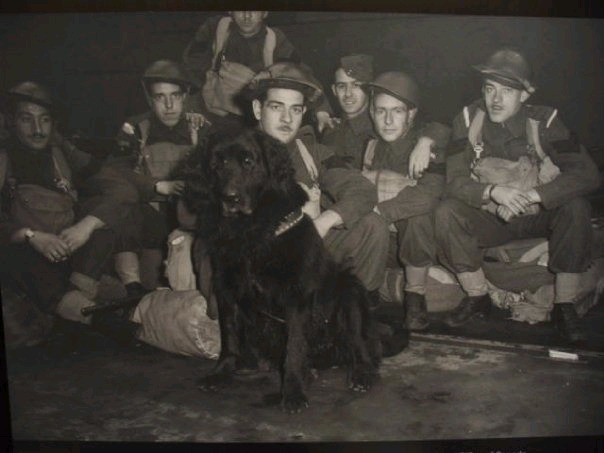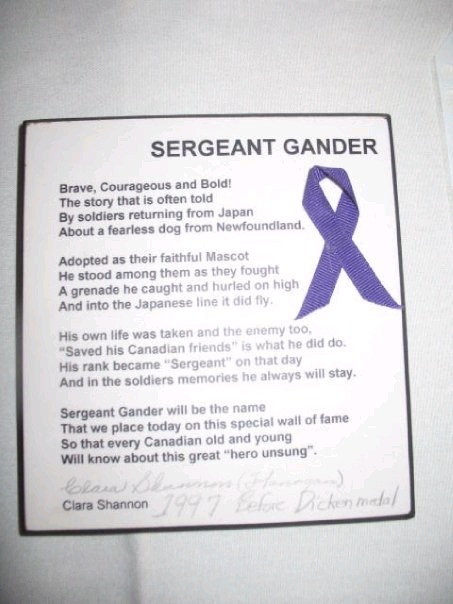Reader Tasha McGee has kindly sent along a story related to one we did in Uncle John’s Bathroom Reader Plunges Into Canada, Eh, and also related to her own family history:
I was just reading “Plunges Into Canada” (love it, but the way), and I came across the story about Gander the dog. Well, I was in Ottawa in August ’09 for the Hong Kong Veterans Memorial Wall unveiling (my grandpa was a P.O.W) and there was a bunch of… memorabilia, I guess you’d call it, about the war time. I took the following pictures that I thought I would share.
Really appreciate it, Tasha, must have been quite a trip. Here’s that photo of Sergeant Gander:
That is one good looking dog. And from Plunges Into Canada (page 37)—here’s the truly amazing story of Sergeant Gander:
DARK DOG DAYS
After a brutal defeat during World War II, Canadian survivors
and prisoners of war took some cheer in telling tales about
Gander the dog, a mascot that saved their lives.A HEROIC TAIL
Locked for four years in a squalid Japanese prison camp, sick, ankle deep in mud, without enough to eat—that was the state of the Canadian survivors of the 1941 Battle of Hong Kong. They were ostensibly the lucky ones (they survived); more than 500 Canadians did not.With the horrors the inmates had seen in battle and the tortures they experienced daily behind the barbed wire, there wasn’t a lot to comfort them. So it’s not surprising that they held on to small pleasures…like recounting the legendary exploits of a black dog named Gander who protected his companion soldiers and bested the Japanese army, even when it cost him his life.
THE DOG BEHIND THE MYTH
Gander started out as Pal. The dog was a Newfoundland, a breed that’s known for its sweet disposition, strength, loyalty, and size (up to 68 kilograms/150 pounds when fully grown). Pal was living with a family in the town of Gander in the early days of World War II. As he grew ever larger, the family started wondering if they’d chosen the right breed of dog, considering that they had children. When he exuberantly jumped on one of the kids’ friends and accidentally scratched the little girl’s face, the family started looking for a new home for Pal.At the time, the Gander airport had been turned into an air base and was teeming with soldiers. Like most dogs in the town, Pal roamed freely. Plus, he was friendly, so he was well known by the townsfolk and soldiers. Hearing that he needed a home, members of a Quebec rifle regiment offered to take Pal on as a mascot. They changed his name to Gander and “promoted” him to sergeant, even affixing sergeant stripes to his collar. And when, in October 1941, they shipped out to Hong Kong, the soldiers took their now-beloved dog with them.
Initially, life was good. Their military paychecks were enoughfor the men to live like kings in Hong Kong, and although there were reports of fighting elsewhere, the city was peaceful. There was no evidence of impending invasion, and the Canadian forces settled into the routine of garrison duty. They visited the sights, and Gander spent warm afternoons sleeping on a veranda in the sun.
PARADISE LOST
The Japanese military, though, had other plans for Hong Kong, and in the first week of December, they attacked. The Canadians and their allies were outnumbered three to one, and the Quebec soldiers ended up on the front lines, trying to save the British colony from becoming a Japanese one. Japanese ships shelled the island, and its troops started landing. Fighting got intense along the beaches, and Gander was right there, unafraid (the stories would say). The earsplitting sounds of rifles and explosions didn’t make him flinch. All he wanted to do was take care of his men, like any good sergeant would.As Japanese troops began landing on the beach, Gander ran at them, barking, snarling, and snapping at their legs, sending them back into the water and diverting them away from his men’s position. Somehow, he didn’t get shot.
One often-told story had Gander looking after wounded Canadian soldiers who were lying near a road. Japanese troops appeared and began walking toward where the men were partially hidden in the brush. Gander charged at the Japanese, barking and growling. They decided to change direction, giving Gander wide berth and saving the Canadians from discovery.
The most significant incident, though, sealed Gander’s legendary status, and, in 2000, also won him the animals-only Dickin Medal for “acts of conspicuous gallantry and devotion to duty in wartime.” During close fighting, Gander’s soldiers were pinned down. When a Japanese soldier threw a grenade into their midst, Gander didn’t hesitate. He swooped up the grenade with his mouth and ran toward the man who threw it. Some people say he knew what he was doing and deliberately risked his own life for his men. But others argue it’s likely he was just playing a game of fetch. Either way, it saved the soldiers’ lives. Gander didn’t make it, though. The grenade exploded as he ran, killing him instantly.
THE BLACK BEAST
Hong Kong fell to the Japanese just 18 days after the battle began, and all the surviving Canadian soldiers were sent to prison camps. And that bred one last, posthumous story about Gander triumphing over the enemy. According to the anecdotes, Canadian prisoners were interrogated about a special “weapon” that clearly concerned the Japanese: the fearless “black devils” or “black beasts” that had accompanied them to battle. The soldiers said nothing, simply allowing the Japanese to believe that Canada had bred some kind of super animal to fight in its army.In 1945, the war ended, and the surviving soldiers went home. But they never forgot about Gander. In 2009, when a Hong Kong Veterans Memorial Wall went up in Ottawa, listing the 1,977 Canadians who served in the battle, survivors insisted that Gander’s name be added.
One more photo, from Tasha:









